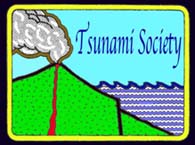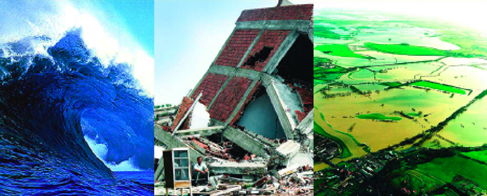..........................................................
ABSTRACTS
for Volume 31, No. 3
ABSTRACTS for Volume 31, No 3
Complete Journal - STHVol31N3Y2012.pdf ( 48 MB) Compressed Journal (1.7 MB)
TSUNAMI PROPAGATION OVER THE NORTH PACIFIC: DISPERSIVE AND NONDISPERSIVE MODELS (8.2 MB)Compressed(492 KB)
Juan Horrillo - Texas A&M University at Galveston (TAMUG),USA
William Knight - NOAA / West Coast & Alaska Tsunami Warning Center, Palmer, Alaska,USA
Zygmunt Kowalik - Institute of Marine Science, University of Alaska Fairbanks, Fairbanks, AK. 99775, USA
ABSTRACT
Hydrostatic (HY) and non-hydrostatic (NHY) tsunami physics is compared by application to the Kuril Island Tsunami (KIT) of November 2006 and the Japan Tsunami (JT) of March 2011. Our purpose is to study the significance of dispersive vs. non-dispersive long waves on global tsunami propagation. A tool which is well suited to revealing tsunami wave transformations is the energy flux. Expressions for dispersive and non-dispersive fluxes have been formulated. This provides an understanding of the role of dispersion in tsunami propagation and dissipation. Separating the pressure field into two parts i.e., HY and NHY shows that dispersive waves extract energy from the main wave, directing the dispersive energy flux away from the wave front. The major result of the application of the energy flux to non-dispersive waves is an enhanced understanding of later tsunami wave train arrivals at distant points – with arrivals sometimes occurring several hours after an initial forerunner wave. Computations show that strong differences between non-dispersive and dispersive waves develop along the length of the main energy beam. This has important consequences for accurate tsunami prediction and warnings.
Key Words: Japan and Kuril tsunamis, hydrostatic and non-hydrostatic numerical modeling, dispersive and non-dispersive energy flux
Science of Tsunami Hazards, Vol. 31, No. 3, page 154 (2012)
--------------------------
CATASTROPHIC FLANK COLLAPSE ON TA’U ISLAND AND SUBSEQUENT TSUNAMI: HAS THIS OCCURRED DURING THE LAST 170 YEARS? (12.1 MB)Compressed(524 KB)
Shaun Williams, Tim Davies, Jim Cole
Natural Hazards Research Centre
Department of Geological Sciences
University of Canterbury, PB 4800
Christchurch, New Zealand
ABSTRACT
Ta’u, the easternmost inhabited island in the Samoan Islands archipelago, exhibits a series of down-faulted benches on its southern flank, believed to be the remnant of ~30 km3 catastrophic collapse. A historical map of Ta’u charted in 1839 during the United States Exploring Expedition, which did not show the benches, suggests that the event occurred less than 170 years ago. A collapse event of this magnitude would have generated a locally devastating tsunami, with possible impacts experienced at the regional level. However, no written or oral records of such an event exist. A number of key questions thus emerge, and formed the basis for this study. Did this event actually happen within the last 170 years, and if so, how and why could it have gone unnoticed? Or, is the event much older than the impression obtained from the literature? The catastrophic flank collapse was modeled using 100 m contour-resolution bathymetry data of the Ta’u region, coupled with rational assumptions made on the geometry of the failed mass. This enabled numerical landslide-tsunami simulation in the Cornell Multigrid Coupled Tsunami Model (COMCOT). The results indicate that if an event of this magnitude occurred in the last 170 years, it could not have gone unnoticed by local inhabitants. It thus seems likely that the initial survey conducted during the Exploring Expedition was inaccurate. Nevertheless, the well-preserved nature of the benches indicates collapse relatively recently and raises the possibility of future collapse.
Keywords: Volcanic flank collapse, Ta’u Island volcano, tsunami,
Science of Tsunami Hazards, Vol. 31, No. 3, page 178 (2012)
___________________________
THE 2010 CHILEAN TSUNAMI: BEHAVIOR ON THE ECUADORIAN COAST AND THE GALAPAGOS ISLANDS (1.7 MB)Compressed (205 KB)
H. Moreano - Instituto de Investigación Científica y Desarrollo Tecnológico, Centro de Estudios Integrales del Ambiente. Universidad Estatal Península de Santa Elena, La Libertad, ECUADOR
P. Arreaga - Laboratorio de Tsunamis. Instituto Oceanográfico de la Armada, Guayaquil, ECUADOR
J. Nath - Departamento de Hidrografía, Sección Mareas. Instituto Oceanográfico de la Armada, Guayaquil, ECUADOR.
ABSTRACT
Available mareograms from ports of Ecuador and the Galapagos Islands made possible analysis and understanding of the tsunami generated by the great Chile earthquake of 27 February 2010. In general, all tidal gauges along the coastal zones at these localities begun to record sea level changes minutes after the predicted low water tide near 08:30 in the morning of February 27. The mareographic records showed waves with amplitudes ranging from 20 to 70 cm and periods of up to 2 hours. From then on the records indicated lower amplitude waves and rather short periods perhaps due to local conditions at each port. At Caleta, Aeolian and Baltra Island in the Galapagos, sea level changes begun just before low tide. Recorded waves in Academy Bay of Puerto Ayora (Santa Cruz Island) ranged at about 35 cm in amplitude and boats sat on the rocky bottom at around 07:30 (local time). Initial periods were less than 60 minutes but later were shorter - possibly because of the port’s configuration. The water level fluctuations lasted for about 48 hours. Along the coast of Ecuador the tsunami wave amplitudes ranged between 20 and 70 cm the periods were longer but shorter in the Galapagos Islands. Based on initial sea level changes and the issuance of a tsunami warning at Puerto Ayora on Santa Cruz Island, there was evacuation of coastal inhabitants to safer, higher grounds.
Keywords: Tsunami Chile 2010, Impact on Ecuador and Galapagos Islands.
Science of Tsunami Hazards, Vol. 31, No. 3, page 199 (2012)
_____________________________
POTENTIAL OF TSUNAMI GENERATION ALONG THE COLOMBIA/ECUADOR SUBDUCTION MARGIN AND THE DOLORES-GUAYAQUIL MEGA-THRUST (26.2 MB) Compressed (336 KB)
George Pararas-Carayannis - Tsunami Society International, Honolulu, Hawaii, USA
ABSTRACT
The Colombia/Ecuador subduction zone is a region where high seismic stress is presently accumulating. Statistical probability studies and GPS measurements of crustal deformation indicate that the region has an increased potential to generate in the near future a major or great tsunamigenic earthquake similar to the 1979 or 1906. Although most of the major earthquakes along this margin usually generate local tsunamis, the recurrence of a great mega-thrust, inter-plate earthquake, similar in magnitude and rupture to the 1906 event (Mw=8.8, rupture 600 km.), can generate a tsunami with destructive near and far-field impacts. To understand the potential for such destructive tsunami generation in this region, the present study examines and evaluates: a) the controlling inter-plate coupling mechanisms of the tectonic regime of the margin – including lithospheric structure deformation, sea-floor relief and the subduction or accretion of highly folded, hydrated sediments along the seismogenic zone of southern Colombia/North Ecuador; b) the seismo-dynamics and role in tsunami generation as affected by the Carnegie Ridge’s oblique subduction beneath the South American continent; and c) the seismotectonic extensional processes in the vicinity of the Gulf of Guayaquil-Tumbes Basin and how the northwestward movement of the North Andes block away from the South American continent along the Dolores Guayaquil mega-thrust and the resulting strain rotation may cause sudden detachment, décollement and deformation, with the potential for local tsunami generation that may affect the Gulf of Guayaquil and other coastal areas along southern Ecuador.
Keywords:Colombia/Ecuador Trench, subduction, tsunami, earthquake, Carnegie Ridge, Guayaquil-Tumbes Basin, Dolores Guayaquil megathrust.
Science of Tsunami Hazards, Vol. 31, No. 3, page 209 (2012)
__________________________
..........................................................
Copyright © 2012 - TSUNAMI SOCIETY INTERNATIONAL
-------------------------------------------------------------------------------------------------------------------------------------------




